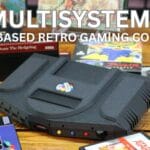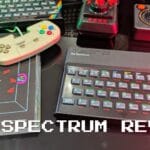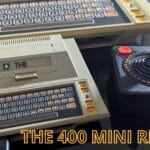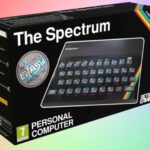Table of Contents
In this short video series I start with giving this Amstrad CPC 6128 a good clean up. The Amstrad CPC 6128 is working fine so just some minor repairs, but it is not the best looking with very yellowed keyboard keys and dirty logo. I take the whole lot apart, clean everything up, retrobright the keys, and put it all back together again.
Amstrad CPC 6128 Retro Restore Video
In the second forthcoming part of the video I take a look at some of the addons and accessories to pimp up your 6128!
Gear used in this video
(Contains affiliate links)
Contact Cleaner – https://amzn.to/3jIbWoK
Isopropyl Alcohol – https://amzn.to/376iBUB
ESD Brushes Kit – https://amzn.to/3aX3YEc
Compu Cleaner Air Duster – https://amzn.to/3qcu5xg
Jerome Russell Bblonde 40 Vol 12% Peroxide Cream 5ml – https://amzn.to/373P8dS
Onforu UV Strip Light – https://amzn.to/3jEGYxs
Amstrad CPC 6128 Retro Restore (Text)
This 6128 is in working order as I have already tested it and it is working great. I have already replaced the original disc drive with a Gotek. The original drive had the usual broken drive belt which I have replaced and tested. Apart from that, the Amstrad CPC 6128 is as the day it was made.
Physically it is in fairly good condition, a few light scratches and small dents here and there on the case. The main issue is those keyboard keys which have turned yellow and are caked with dirt. These will definitely need cleaning and very likely retrobrighting.
I start with flipping over the case and unscrewing the case screws. There’s seven screws on the bottom and usually two on the side for the disk drive, as I have already replaced the drive previously, these screws were not needed.
You need to be careful when opening the case as there are ribbons and cables connecting the keyboard, power LED and speaker from the bottom to top half of the case. Folding it over and laying it flat is the safest way of opening it.
I remove the screw holding the Power LED board in place and then remove this and slide out the speaker. The blue and white cables can then be removed from the plastic clips.
The two cables for the keyboard can now be disconnected. They feel quite fragile so be very careful when removing them. Once they have been both removed, the case is now in two halves and easier to work with.
I want to get started on the keyboard keys straight away. There’s three screws holding the keyboard on to the case. Once unscrewed, the keyboard can then be removed from the case.
Always use a key puller, they only cost a few pounds and it makes removing keys far easier and less chance of breaking something. These keys are fairly easy to remove, they have springs underneath so be careful of flying springs. Also, keep in mind that a few of the keys have metal bars in place and should not be removed until the bars have been removed. I will do those after as you need to open the back half.
The back half is held in place with some plastic clips. You can push these clips with your finger or a screwdriver if they are a bit stiff. The metal plate can now be lifted off to reveal the keyboard membrane. Be careful with this as it feels quite fragile.
The metal bars can now be removed by pushing the sides of the bars away from the key. It took me two attempts to work it out 🙂 Once the bars have been removed, the keys come out just as easy as the others. I did notice that the two space bar springs are slightly smaller in size than the others, so keep those separated from the others.
The keyboard shell is absolutely caked in dirt, dust and who knows what else. Thankfully it’s plain plastic so cleaning is easy. It can go straight into some warm soapy water for a soak and scrub.
The keys can also go in the water for a soak for a while.
While they are soaking I clean the keyboard membrane. First I gently wipe over the area with a microfibre cloth to remove any loose dirt. I then spray some isopropyl alcohol and again gently wipe over both sides to remove any stubborn dirt.
I let the keys soak for an hour and now is the boring task of cleaning and drying them. All the dirt has come off of them, but as expected they have yellowed. They should naturally be a light grey colour and will need retrobrighting.
With some 40% vol bblonde cream and a brush, I apply the cream on to the keys and place them on some cardboard. These keys are a little awkward as the bottoms are not flat and have a few protruding clips. This means they will have to sit at an angle, I will need to turn them around halfway through the retrobrightening process to ensure they get an even brightening.
Once all the keys have been covered I place some cling film over the cardboard and hold it in place with some tape to keep it secure. It is then put in my retrobrighting box, check out my Atari ST retro restore video for more details on that.
While the keys are retrobrighting I can get on with the rest of the 6128. The gotek is held in with one screw. The ground wire is on there as well, although it’s not needed for the gotek, but it keeps it in place and not floating around loose in the case. The power and data cables can also be disconnected.
The motherboard has a few screws holding it to the case. There’s also the volume dial and power switch that can be lifted out before removing the motherboard.
The board is in good condition and no busted capacitors, I will probably replace these at a later date though. So for now it can have a general clean up with some IPA and an anti static brush.
The expansion connectors are quite dirty and definitely need some attention. I use some contact cleaner and a cotton bud to clean them. Always clean up and down the contact and not across them as you may accidentally lift up the contact.
I repeat this for all the contacts on both sides. You can see quite a bit of dirt is coming off.
I also spray some contact cleaner into the power switch and volume dial mechanisms to clean them up a bit. And finally, I clean up the ports to remove any dirt and dust.
I am in two minds to leave this power cable connected as I will be mainly using it with a separate power supply and RGB Scart cable. This makes this power cable redundant, but for the moment I leave it connected as I want to try it with the original monitor.
Now both the top and bottom half of the cases are empty, I can give them a good cleaning with some warm soapy water. A sponge will do the job for the majority of the case, and for the areas such as the grills and lettering I use a toothbrush to get into the surface.
I repeat the process for the bottom half of the case.
I forgot to record this, but off camera I gave the silver Amstrad logo a really good scrubbing. It took awhile but eventually the grime came off and it is now shiny again as you will see later.
Now everything is clean I can start reassembling the bottom half of the case. starting with the motherboard I refit all the screws. After that I refit the power switch and volume dial parts. I put the power switch in the wrong way around and did not notice. It just means you flick the switch the other way and won’t cause any issues, so I had to reopen the case and turn it back over 🙂
The Gotek floppy drive can now be fitted. I use some of these double sided sticky pads to help keep it in place as the screw only holds it on one side. When you use the gotek and push the button it will move around otherwise.
The keys have been retrorbrighting for several hours and around halfway through I turned them around to help give them an even spread. They can now be rinsed off and dried once again. I won’t bore you with more footage of me drying the keys 🙂
And now to put all the keys back on the keyboard. I start with putting the metal bars on the keyboard shell. Starting with the space bar which is usually a pain in the arse on keyboards, it’s very easy on the Amstrad! I then do the other keys which have the metal bar.
Once they have been done I proceed with the rest of the keys. Referring to a photo I previously took and organising the keys into groups it is fairly straightforward. One thing to note, before adding the springs, give them a visual check and a twist to ensure that the springs have not wrapped around each other.
Flipping the shell over, I then add the keyboard membrane. The holes on the membrane line up to the plastic clips so it will only go in one way. The metal plate can then be fitted and the clips pushed through.
The keyboard can then be reattached to the Amstrad CPC 6128 case with the three screws.
Then the two halves can be reconnected. I start with the power LED, it only goes in one way and is held in place with a screw that I add a bit later. The speaker can also be pushed back into its slot. The wires can then be pushed into the plastic clips to keep them secure.
Next are the two keyboard ribbons. These feel very fragile to insert so be careful and take your time when doing it. I find the best way to push them in is hold them with fingertips each side and push down. Another is that there is usually a plastic covering which you can get a fingernail on and push in. It mainly depends on the angle of the connector if it’s facing upwards or flat on the board.
The two halves of the case can now be joined, I had to jiggle around the wires a little to make sure that they were not getting squashed or caught on anything.. Then the case screws can be put back in and its job done!
I have had the following two kind of addons which sit underneath the monitor for some time now, and I have never used them. First is the CT-1 Radio Clock unit. It still has the warranty and money back cards, I wonder if they are still valid 🙂
The unit acts as a standalone clock/radio player, it doesn’t interact with the Amstrad CPC 6128 in any way. Amstrad were famous for their stack systems and this extended to their computers as well as HiFi systems.
I powered it on and dialed through the frequencies and picked up a few radio stations. Ignore the LCD, I think the camera was picking up fluctuations, it was perfectly fine to look at.
The case just needs a general clean with some IPA and the dials and sliders have a quick squirt of contact cleaner and some action to clean the contacts.
The second unit is the MP-3 Computer Modulator Convertor. This essentially is a TV tuner which connects to the monitor and turns it into a TV. I won’t be using this other than decoration as its analogue TV frequencies only and they are no longer used in the UK.. Maybe it could be modded for something else, any ideas?
Anyway, I give it a quick wipe over and contact cleaner in the dials with some action on them to shift any dirt on them.
Here are the two units stacked, the monitor will go on top of these.
Together these make the original Tower of Power, long before the Mega Drive 🙂
The visual difference is instantly noticeable. Starting with the keyboard which was very yellowed and thick with years of dirt. The keys are now clean and restored to their light grey colour.
The amstrad logo was also very dirty and after some attention it is now back to its former shiny glory.
There are a few minor scratches and dents which I will leave as they are. Trying to fix these will probably make them look worse than they are.
The colouring next to the power LED and on the disk drive text have faded, especially the red colour. I could probably get replacements for these, I will look into if they are a decent price. Otherwise I think they will have to stay this colour for now.
Now to power on and see if I managed to break anything 🙂 We have the boot up screen which is a good sign. Ignore the shadowing on the text, it was a pain to get a clear video as the camera was out of sync and flickering etc.
The keyboard is working fine and a quick classic listing works.
To list the disc contents you type in cat, short for catalogue I guess? This will show all the files on the disc. You then start a program with run, quotation marks and then the file name. Let’s load up the classic Rick Dangerous 2.
The gotek floppy drive emulator has a speaker to mimic the drive loading mechanism which is cool and also tells us that it is doing something.
And with a click of a finger, jump cut to direct video capture with a capture card 🙂
There doesn’t seem to be any issues at all. Joystick input is working fine, music is blasting out of the internal speaker and headphone jack. The monitor colour is pretty much spot on to what I am seeing on the capture card feed. It’s all working great.
This retro restore has gone pretty much to plan. I knew the Amstrad CPC 6128 was working fine beforehand, so this project was mainly the task of cleaning everything up. The visual difference is massive, I now have clean grey keys instead of dirty yellowed ones. And the Amstrad logo is now shining bright again.
But this video is just the start of the journey for this Amstrad CPC 6128. Now everything is cleaned and ready, we can start to pimp it up in the second part of the video.
The next part I will be going into more detail of the Gotek drive as it is already fitted, I know many people have been asking about them as I have used them in other projects. I will also be covering some other additions including an amazing Wi-Fi board, USB joystick adaptors and more.




